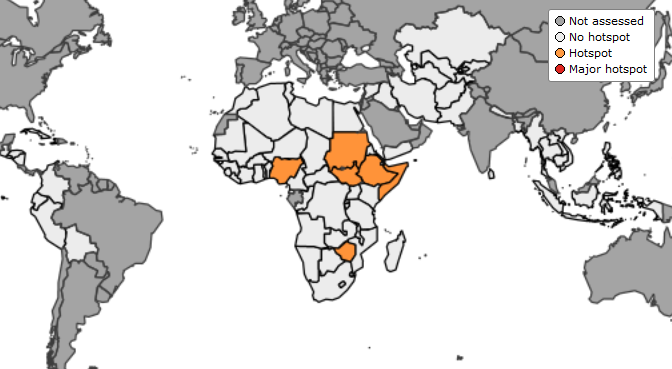
ASAP hotspot assessment September 2020 (updated on 24/09/2020)
© European Union, 2020
The September edition of the JRC's Anomaly Hotspots of Agricultural Production (ASAP) assessment is now available at:
Anomaly Hotspots of Agricultural Production (ASAP) assessment
Main findings of the September global overview:
- In Southern Africa, the winter wheat season is nearing completion and positive production prospects are reported for South Africa, Zambia and Zimbabwe. Outbreaks of African migratory locust are threatening food security conditions in Botswana, Namibia, Zambia and Zimbabwe.
- In East Africa, floods continued to affect riverine areas in Sudan, South Sudan and Ethiopia. Most affected is Sudan, where one third of cultivated areas have been impacted (see more on floods in the ASAP Special Focus for September). Somalia’s first season harvests are significantly below average due to a combination of factors. For the second rainy season, problems with accessing farming inputs may be a limiting factor for planted cropping areas.
- In West and Central Africa, aggregate cereal production prospects are expected to remain above the 5-year average. However, localised production shortfalls are expected in areas affected by flooding and insecurity.
- In North Africa and the Middle East, planting of the next season crops is expected to start in October. In Yemen, conflict and economic decline remain drivers of food insecurity.
- In Central and South Asia, prospects are favourable for the spring wheat harvest, except in north-east Kazakhstan. Good moisture conditions for rice crops are observed in Bangladesh, Sri Lanka and Nepal.
- In South-East and Eastern Asia, conditions are good for wet season rice and irrigated dry season rice, and prospects are favourable. In North Korea, prospects are good for rice and maize; however, possible damage due to excess rainfall may affect localised riverine areas.
- In Central America, the primera season is complete and production is forecast to be average to above average. The postrera season is ongoing under favourable conditions thanks to adequate soil moisture and good rains in September. In Haiti, the main season harvest has been concluded with below-average yields, while conditions are close to average for summer season crop vegetation.
The next assessment is scheduled for the end of October 2020.
Details
- Publication date
- 6 October 2020
